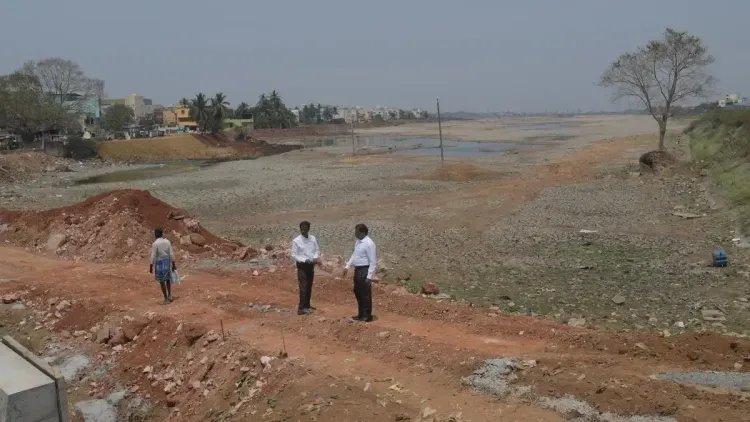Will the park construction on Puzhal Lake's shore harm residents?

Synopsis
Key Takeaways
- Construction of a park near Puzhal Lake is controversial.
- Residents fear flooding and safety risks.
- Environmental stability is a major concern.
- Over 60 concrete pillars have been erected.
- Community suggestions involve relocating the park.
Chennai, Nov 15 (NationPress) The construction of a new park along the banks of Puzhal Lake, a vital source of drinking water for Chennai, has ignited significant controversy among residents, who are concerned that this project may jeopardize the stability of the reservoir's embankment and endanger surrounding communities.
Puzhal Lake, situated in the Tiruvallur district, plays a crucial role in providing a large portion of Chennai's drinking water. When the lake reaches its maximum capacity, excess water is discharged through two sluice gates equipped with shutters. This surplus water flows through a canal for approximately 11 km before eventually reaching the Bay of Bengal near Sadayankuppam.
Flooding has become a persistent problem in several low-lying areas around the lake.
Despite the delicate hydrological situation, the Chennai Metropolitan Development Authority (CMDA) has commenced the development of a public park covering an area of 8.17 acres identified as a zone prone to seepage-water accumulation.
This initiative, part of the North Chennai Development Scheme, is projected to cost Rs 16.96 crore.
As part of the construction efforts, over 60 concrete pillars have been installed along the Chemmanal bank, directly facing Jones Tower. Residents and local activists argue that such extensive civil engineering activities near the reservoir's edge could compromise the integrity of the embankment. Their concerns are valid; earlier this year, a slight weakening of the bund in the same area led to observable water seepage, necessitating the erection of a temporary concrete barrier just a few meters away from the earthen embankment.
Local residents explain that at full capacity, seepage through the red-soil layers naturally slows down water flow, which in turn minimizes wave impact and mitigates erosion. They are now apprehensive that the new pillars could disrupt this natural protective system.
Inhabitants of low-lying neighborhoods fear that any further compromise of the bund could endanger thousands of lives. They propose relocating the park to the vacant land across the lake, close to the temporary bus station.
"Building anything within 200 meters of the lake is alarming. There are safer alternatives," stated one resident.
A senior official from the Chennai Regional Water Resources Department confirmed that constructing a park in a waterlogged area requires a No Objection Certificate (NOC) from their department.
"CMDA officials are optimistic about securing the NOC after completing the project," the official commented.
He added that previous proposals suggested positioning the park near the sluice gates, adjacent to existing concrete protective walls. However, this plan was dismissed, leading to the current choice of the Chemmanal site.
"Some oversights occurred earlier. At this point, halting the work is not feasible," the official remarked.
This situation has raised serious alarms regarding environmental stability, public safety, and the long-term viability of Chennai's water management infrastructure.









